If you’re anything like me when it comes to riding in the dirt, you’re willing to sacrifice a little comfort and user-friendliness in favor of higher performance and better handling. This was pretty much always the case for me as I’d ride my CRF450R both at the track and on the trails, or in the desert/woods/mountains/etc. At the motocross track in its intended environment, the CRF450R is a beast; out in the sticks, the R still rules. However, it definitely gives up certain advantages and conveniences to more trail-inspired bikes like the CRF450X. Fortunately, Honda has built a do-it-all bike for riders like us who don’t want to compromise performance and handling at the track for convenience on the trail – the 2019 Honda CRF450RX.
They say the third time’s the charm, right? Well, now in its third year of production, Honda has ironed out many wrinkles, and this could be the last bike you’ll buy for a long time. Honda’s 2019 CRF Collective introduced seven all-new or reinvigorated models to its lineup, and for 2019, the CRF450RX inherits the same performance-enhancing features as the CRF450R, including key updates for lighter weight, added power, and enhanced handling performance. It also gets some special touches that fine-tune it for enduro/off-road use. These tweaks include a bigger, 2.25-gallon fuel tank, a sidestand, an 18-inch rear wheel, one more tooth on the rear sprocket, a sealed drive chain, and dedicated closed-course off-road suspension settings.
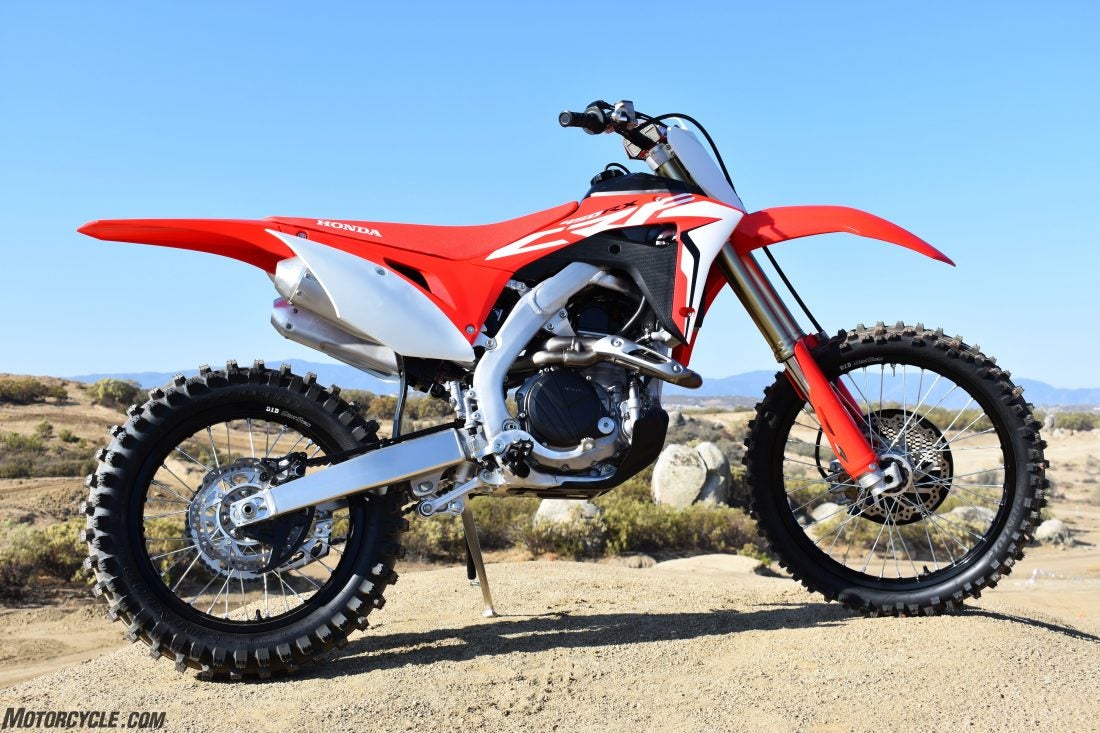
That’s not all, though. Along with the R model, the RX gets an all-new chassis and swingarm designed to work together for improved traction and cornering, the engine features larger-diameter and longer head pipes for better throttle response and top-end pull, and new fuel-injection settings spray twice per cycle to better atomize the fuel. Both the R and the RX share the same 13.5:1 Unicam engine save for slightly different EFI mapping and ignition timing to better tune the power for off-road use. Additionally, there are three different maps to tailor the engine’s output characteristic. Map 1, or Standard, is your all-around power everywhere setting, whereas Map 2 (Smooth) mellows it out a little on the bottom for improved technical riding ability with everything left on top. Map 3 (Aggressive) is the hold-onto-your-hat setting where you better be paying attention, because things can get blurry in a hurry. All three are switchable on the fly.
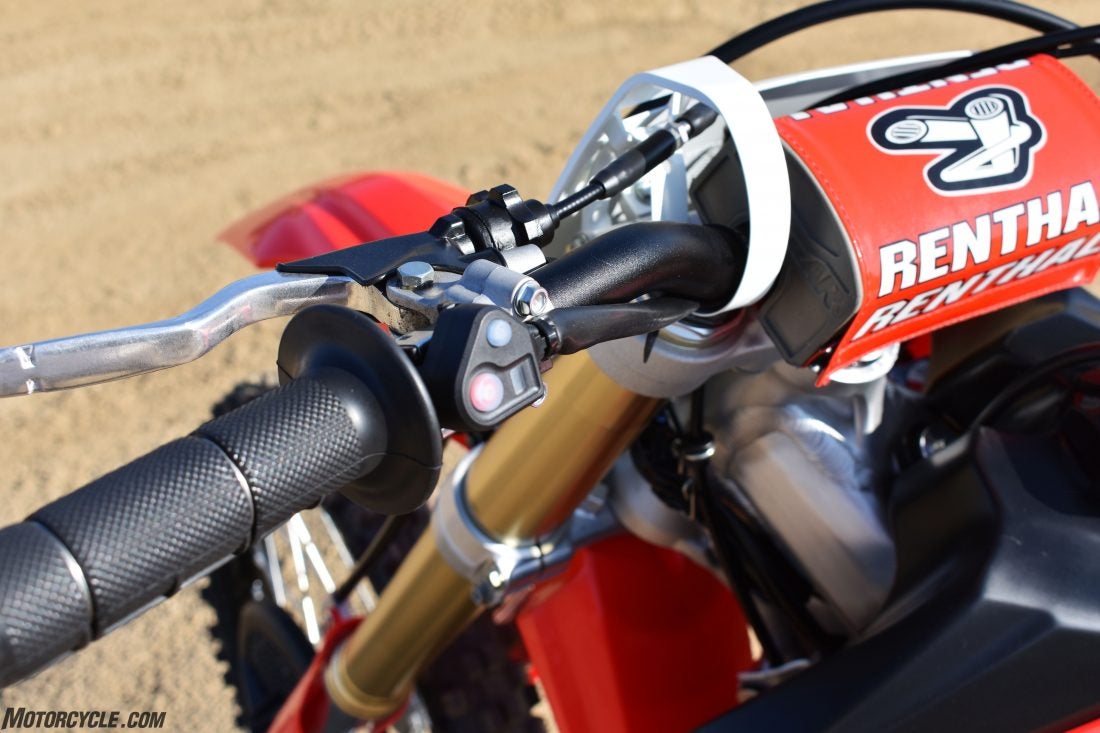
On the track, Maps 1 and 3 are the ones I found myself using most comfortably. The hard-hitting power right off the bottom comes on strong from the get-go and keeps pulling with a super impressive overrev thanks to the new double-spray injector settings and longer header pipes. Utilizing the space gained by eliminating the kick starter and using a compact electric starter instead, the new exhaust features a larger pipe diameter and improved design at the branching location where it splits into its dual mufflers for increased power. Previously 31.8mm, the right and left pipes are now 35mm and 43mm, respectively. In addition, the total tube length (from exhaust port to muffler end) is up 98mm (3.9 inches) on the right and 187mm (7.4 inches) on the left. That’s quite a bit longer, and the difference is certainly felt with better throttle response and top-end pull when riding the 2019 RX back-to-back with the ’18.
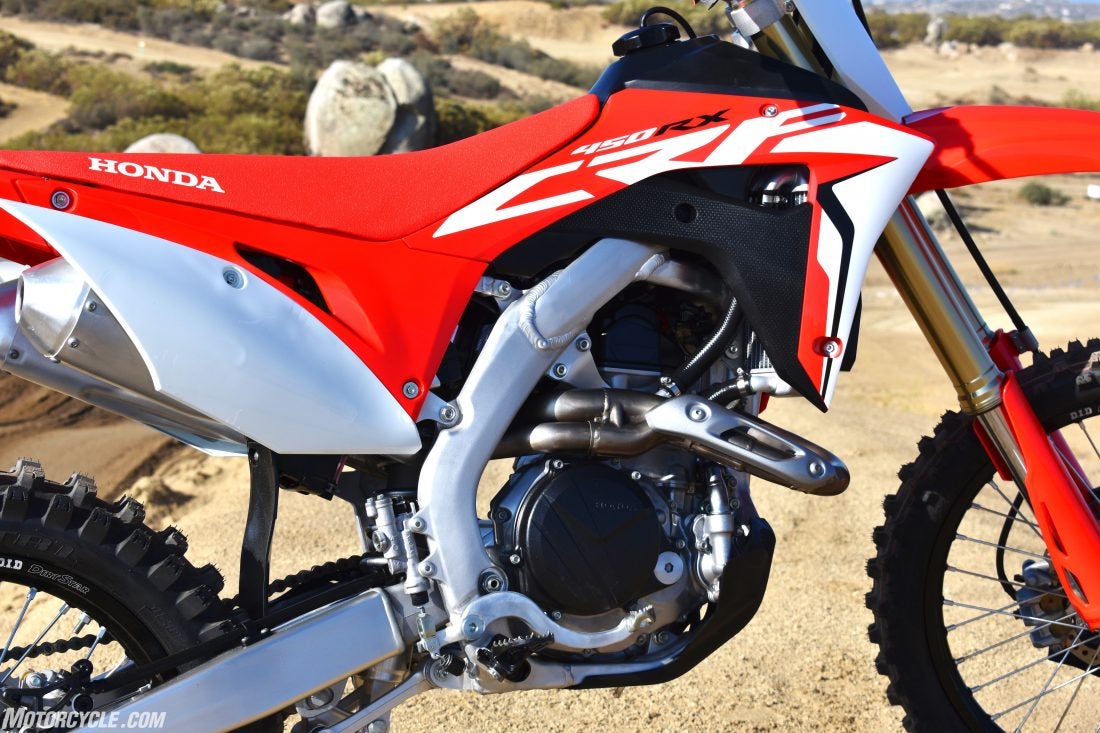
The overrev on the 2019 450RX, simply put, is awesome. Just when you think you’ve run out of gear, the Honda isn’t done yet, and it keeps pulling even longer – surprisingly longer. When it finally does peter out, it does so without falling on its face. This translates to smoother, more efficient riding/racing. Out on the trail, the Smooth Map 2 is what I preferred mostly because the power delivery, especially off the bottom, allowed me to really finesse the bike over trickier, more technical terrain without any sort of herky-jerky on-off throttle response. As the revs climb, though, Map 2 still delivers the same arm-stretching pull the Standard and Aggressive maps provide, giving you the best of both worlds. The 2019 CRF450RX isn’t going to leave you wishing you had more power, that’s for sure.
To match the increase in engine performance, the CRF450RX’s whole chassis and handling department got a makeover, too, with changes to the frame for improved traction and cornering feel plus reduced weight being the main goals. The RX’s Next-Gen twin-spar aluminum frame positions the rear shock’s mounting point lower, which opens up the airbox area and contributes to a lower center of gravity. The frame’s lower members have also been made stiffer to work better with the redesigned swingarm, which is lighter than the 2018’s and has also been optimized in certain areas to improve flex characteristics in conjunction with the chassis as a whole. Where certain areas were stiffened up, others like the rear subframe, got some rigidity taken out to help maintain the bike’s overall balance and feel.
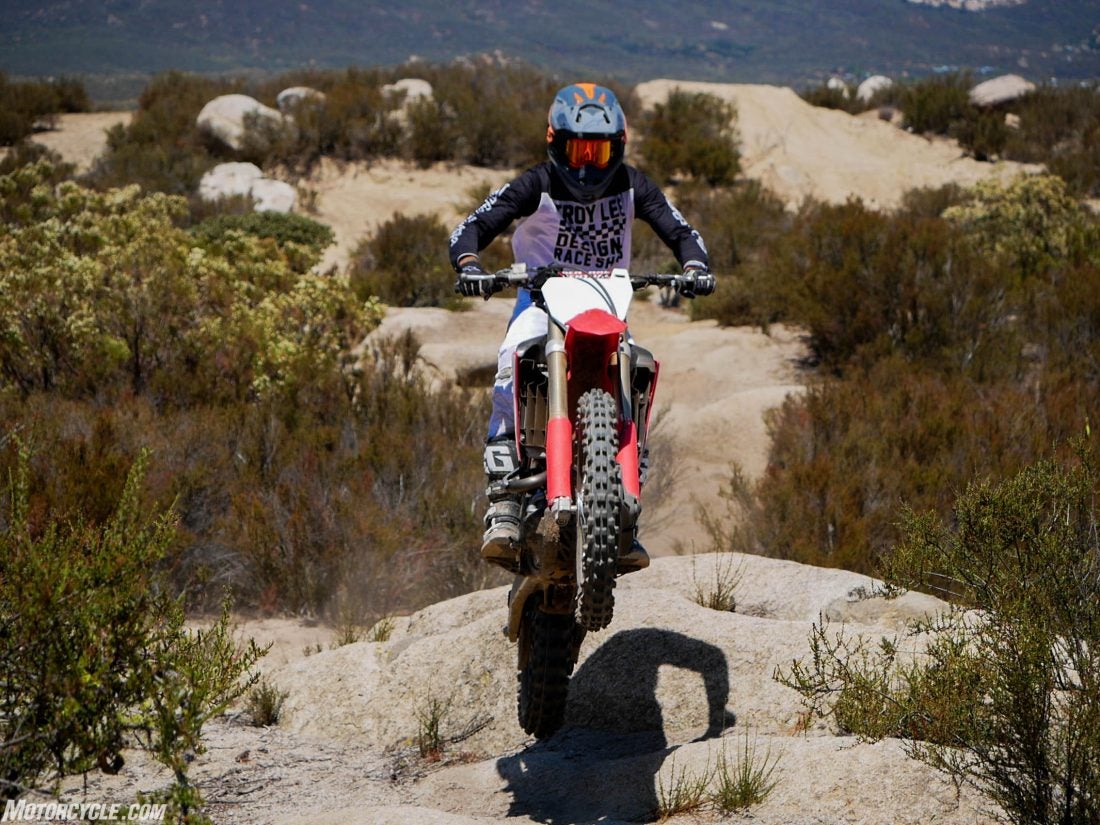
The CRF450RX uses 49mm conventional spring Showa bump sticks with low-friction oil and dedicated damping settings developed from JCR Honda’s Trevor Bollinger and Trevor Stewart in GNCC and WORCS competition. The rear shock is also graced with improved linkage geometry to work better with the all-new swingarm and mounting position within the frame. The top triple clamp features two handlebar mounting locations for moving the handlebar back and forth by 26mm (1 inch). When the handlebar risers are turned 180 degrees, the handlebar can be moved an additional 10mm from the base position, resulting in a total of four unique riding positions. That’s almost 1.5 inches you can move the bars forward or back. Being a taller rider at 6-foot-1, I moved the bars to the forward-most position and felt comfortable on the bike instantly. Opening up the rider triangle helps me get more leverage, but most importantly, it helps me feel more comfortable on the bike and gets rid of the see-saw riding effect of having the bars too close and feeling like they’re in my lap.
All together, the 2019 CRF450RX chassis worked and felt great from the start. The stock valving settings are firm and fast enough to handle jumping and track duty well, yet soft enough to provide plenty of cushion on the trail, too. Both the front fork and rear shock are fully adjustable to fine-tune to your preferences or riding conditions. Heavier and/or more aggressive riders could benefit from stiffer springs, but that’s nothing new – right, fellas?
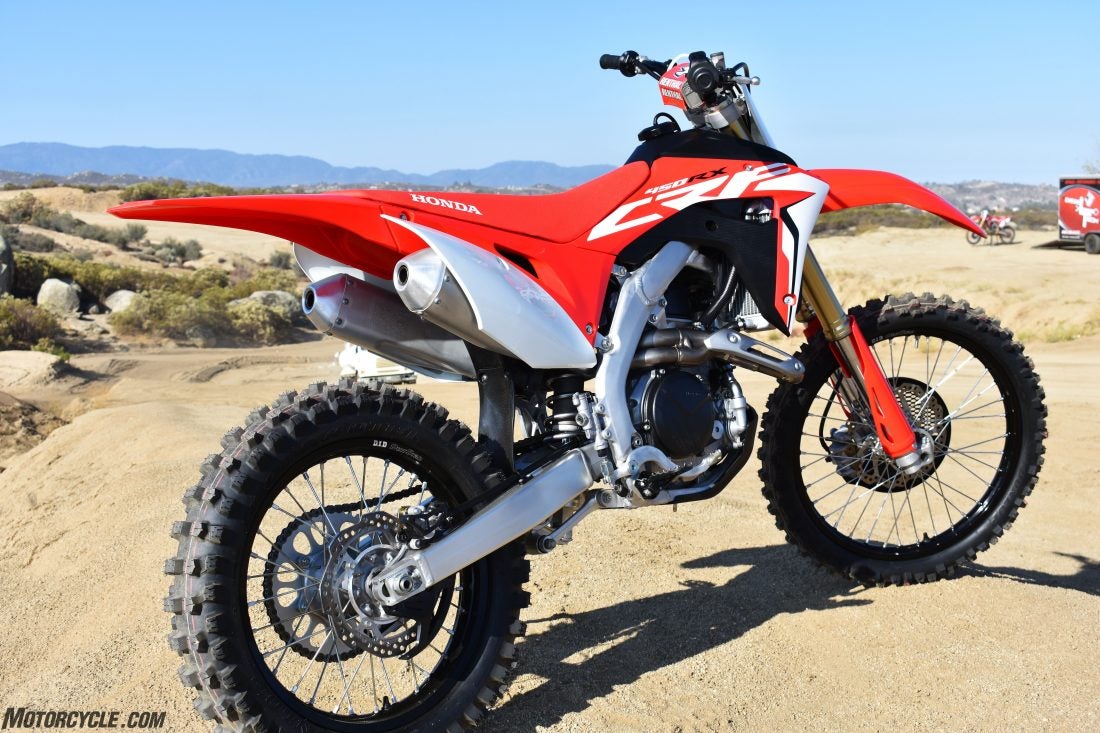
Having the horsepower and handling to go fast is one thing, but it’s nothing if you can’t rein it all in. Fortunately, braking performance and feel have been looked at closely and benefit from increased 260mm front and 240mm rear rotors. Binding the larger front disc is a new, lighter two-pot caliper that uses a pair of 30mm and 27mm pistons, compared to identical 27mm pistons of years prior. The front brake line is also stiffer to prevent brake fade from expansion, maintain precise feel, and improve overall performance.
Other changes to the 2019 CRF450RX include newly shaped footpegs that are 20% lighter and shed mud more easily, redesigned fork protectors for more coverage, black rims which definitely enhance the look of the bike, in-mold graphics that are more resistant to abrasion or peeling from crashing, and a 15mm lower Renthal Fatbar handlebar for a more active riding position. All these changes equate to a better handling and looking bike.

As always, all the good can’t come without a little criticism, and my only real gripe with the 2019 Honda CRF450RX is with its fuel tank. While the bigger 2.25-gallon capacity is awesome and allows you some peace-of-mind to ride longer loops, it protrudes out just a little too far between your legs. Most of the time it’s not a big deal, but there were definitely times, like sticking my leg out in a corner, where I felt somewhat encumbered by it. Fortunately, there are aftermarket companies out there like IMS that make slimmer fuel tanks that hold just as much, if not more than the RX’s stock tank. Another small mention (and this is more of a suggestion than a nitpick) is perhaps adding a sixth gear for the guys who’ll ride the RX more off-road than at the track.
| 2019 Honda CRF450RX | |
+ Highs
|
– Sighs
|
|
In Gear Goggles: Scott Prospect Goggles |
| 2019 Honda CRF450RX Specifications | |
|---|---|
| Engine Type | 449.7cc liquid-cooled 10° single-cylinder four-stroke |
| Valve Train | Unicam OHC, four-valve; 10.0mm intake, steel; 8.8mm exhaust, steel |
| Bore x Stroke | 96.0mm x 62.1mm |
| Compression Ratio | 13.5:1 |
| Induction | Programmed fuel-injection system (PGM-FI); 46mm throttle bore |
| Ignition | Full transistorized |
| Starter | Push-button electric starter |
| Transmission | Constant-mesh 5-speed return; manual |
| Clutch | Multiplate wet (6 springs) |
| Final Drive | #520 sealed chain; 13T/50T |
| Front Suspension | 49mm fully adjustable leading-axle inverted telescopic Showa coil-spring fork |
| Rear Suspension | Pro-Link system; fully adjustable Showa single shock |
| Front Brakes | 2-piston caliper (30mm, 27mm) hydraulic; single 260mm disc |
| Rear Brakes | 1-piston caliper hydraulic; single 240mm disc |
| Front Tire | Dunlop Geomax AT81 90/90-21 w/ tube |
| Rear Tire | Dunlop Geomax AT81 120/90-18 w/ tube |
| Rake (Caster Angle) | 27°25’ |
| Trail | 4.6 in. |
| Length | 85.6 in. |
| Width | 32.6 in. |
| Height | 49.6 in. |
| Ground Clearance | 12.9 in. |
| Seat Height | 37.8 in. |
| Wheelbase | 58.2 in. |
| Fuel Capacity | 2.25 gal. |
| Color | Red |
| Curb Weight | 255 lbs. (claimed) |
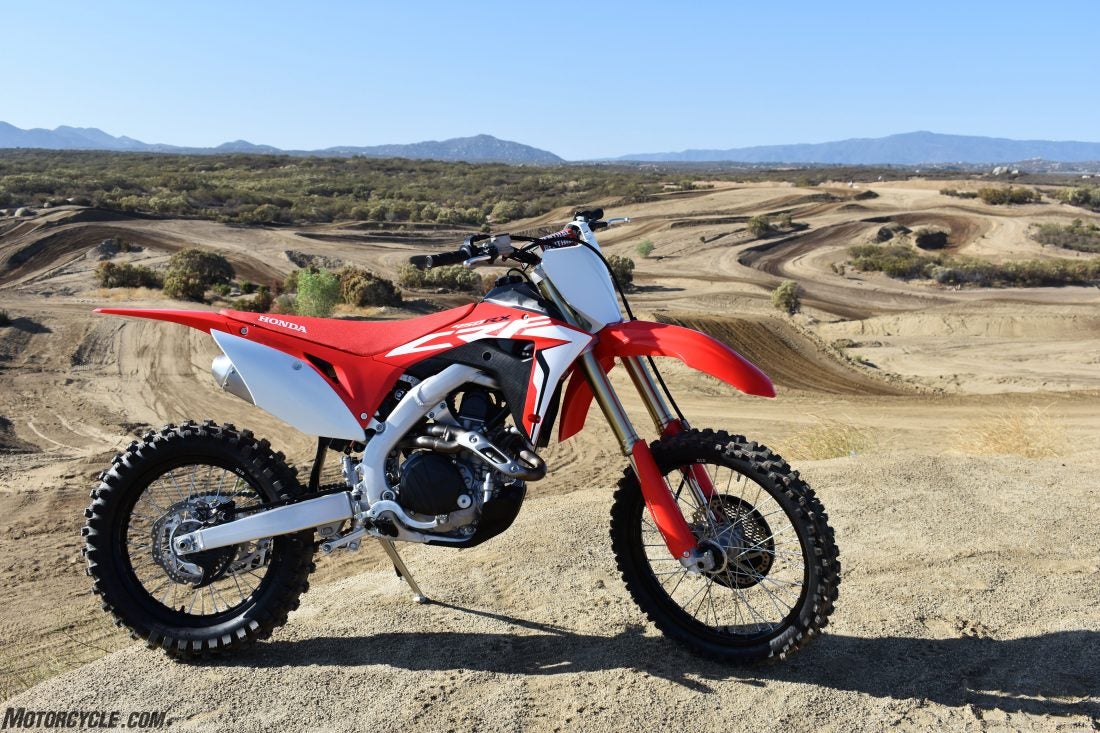
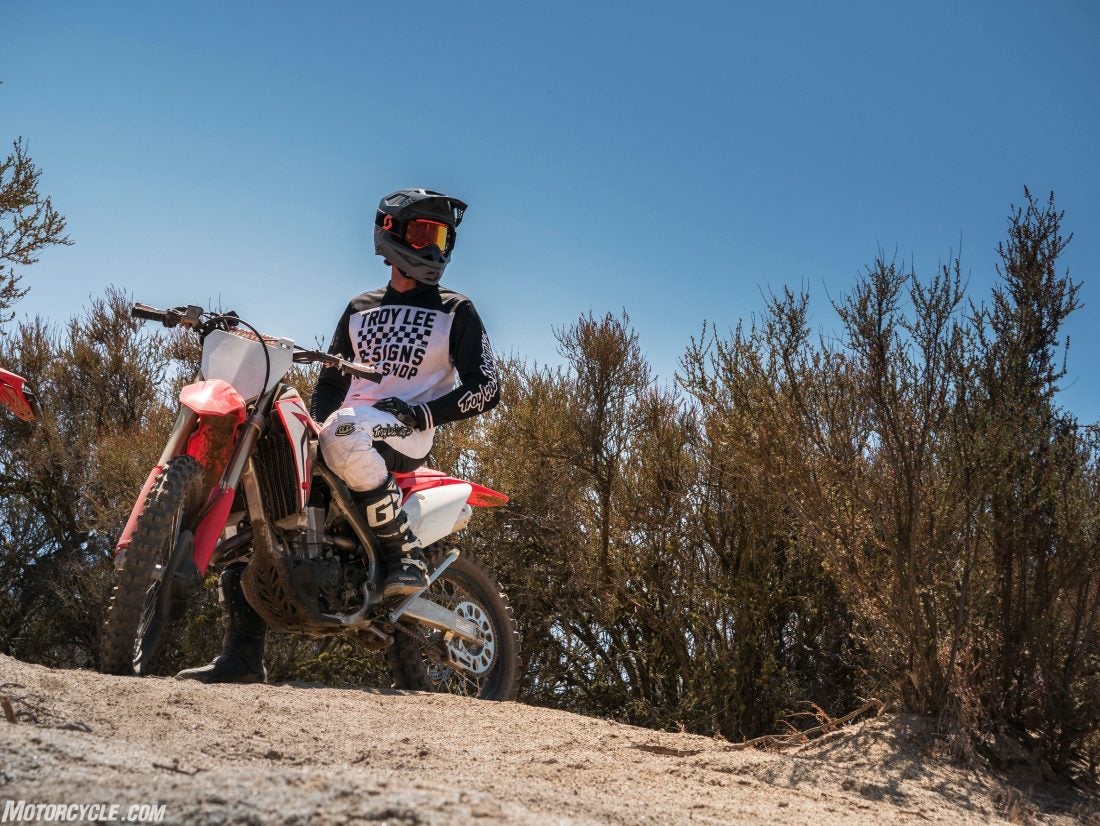
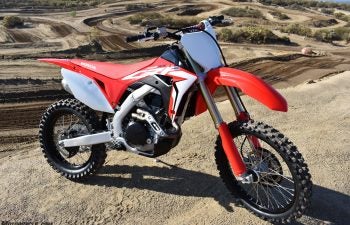
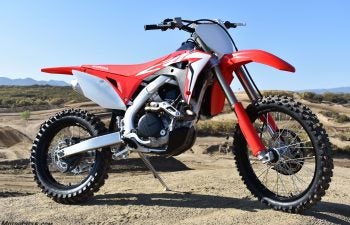
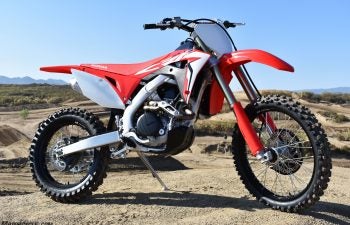
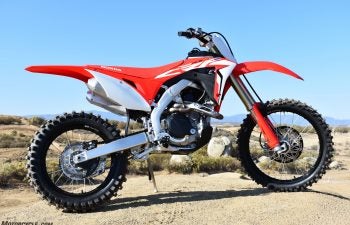
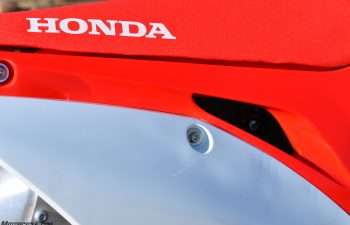
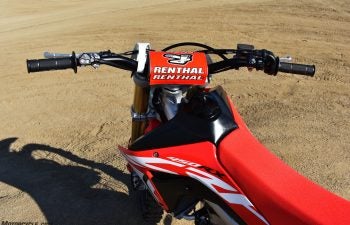
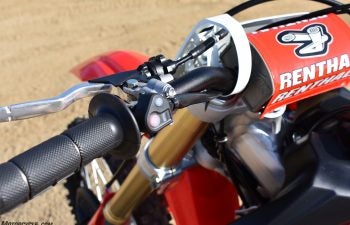
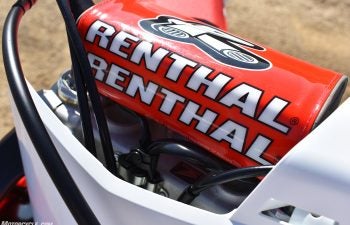

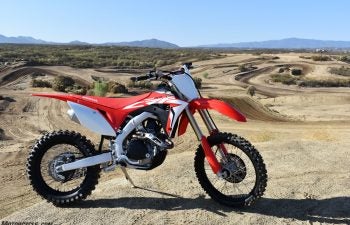
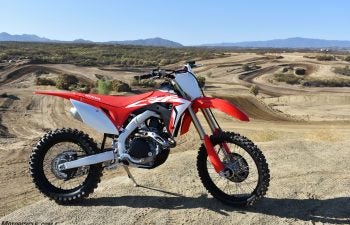
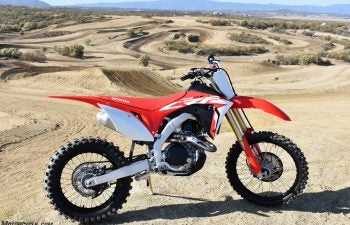
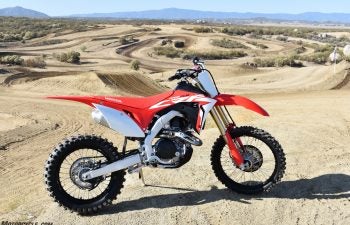
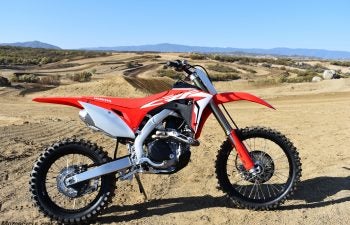
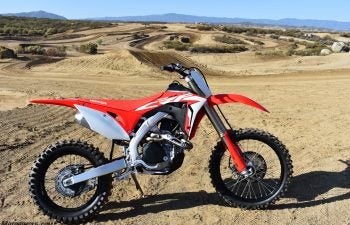
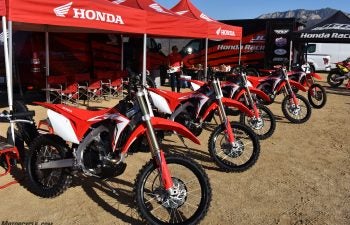
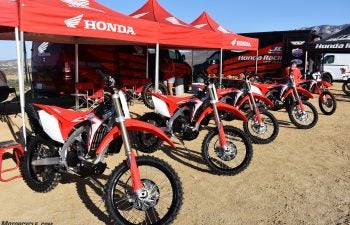
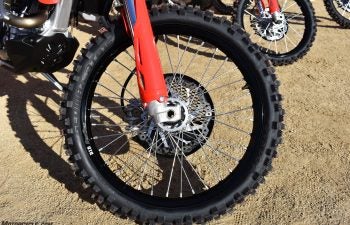
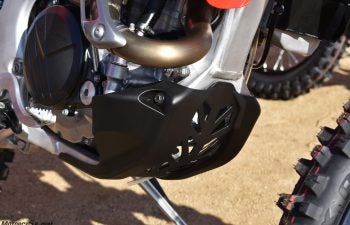
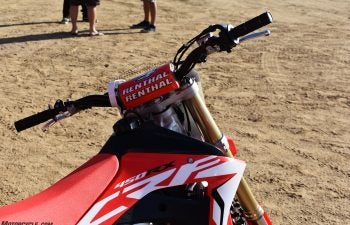
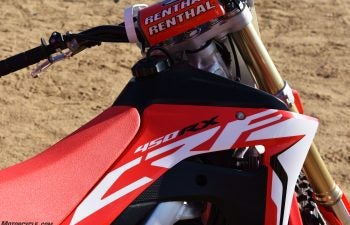
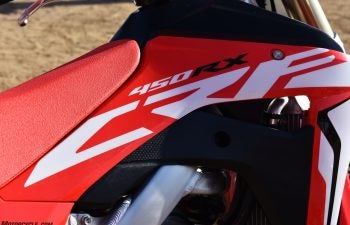
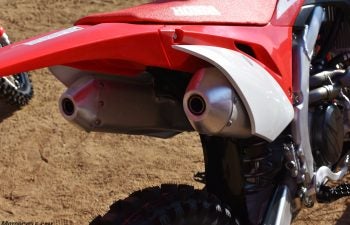
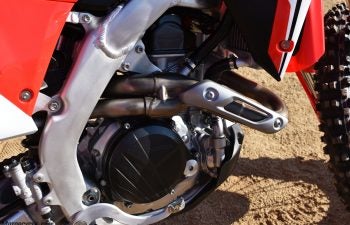
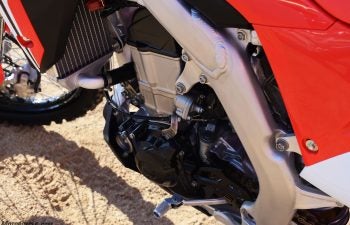
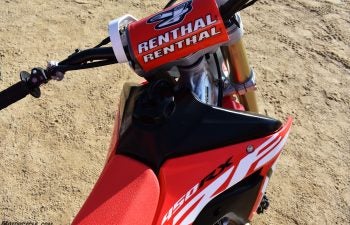
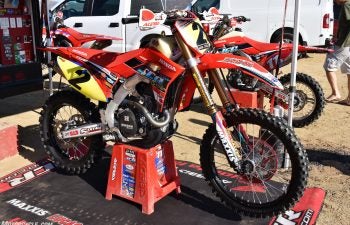
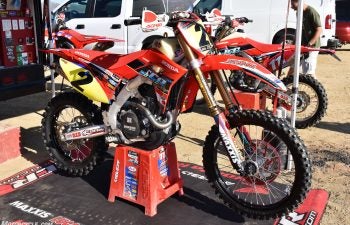
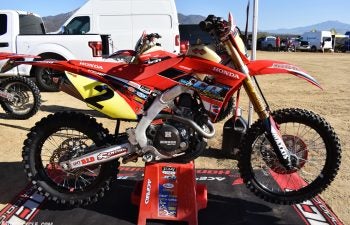
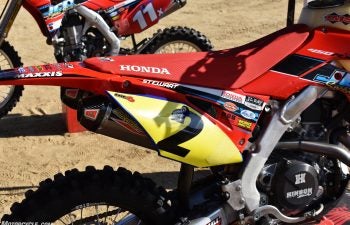
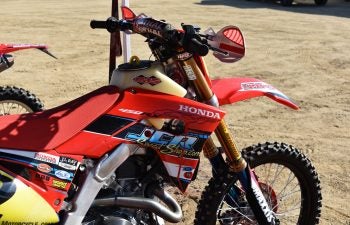
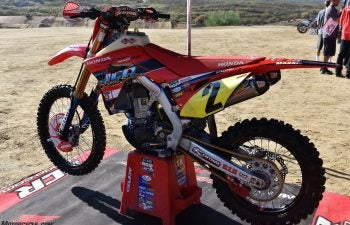
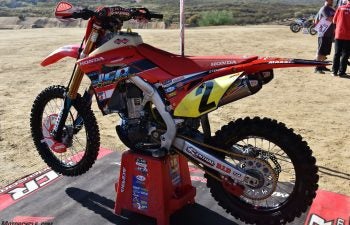
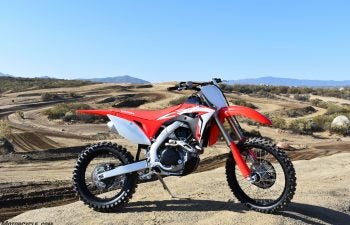
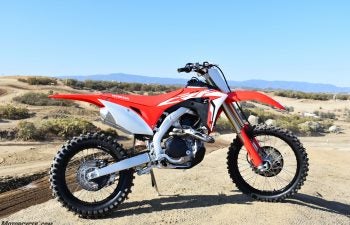
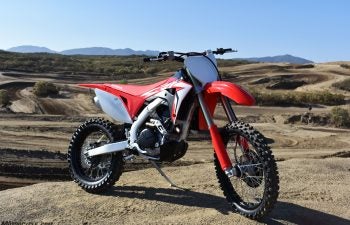
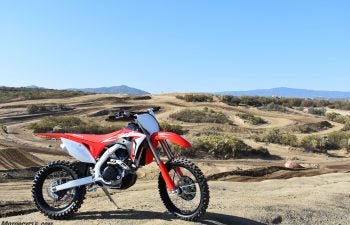
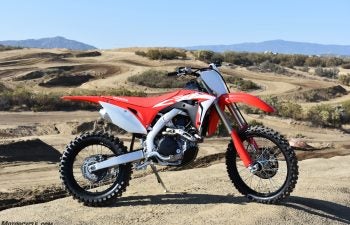
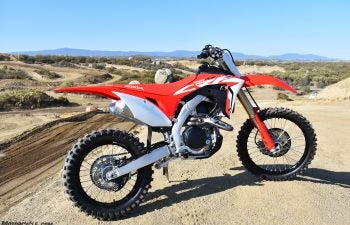
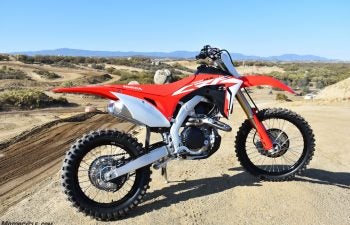
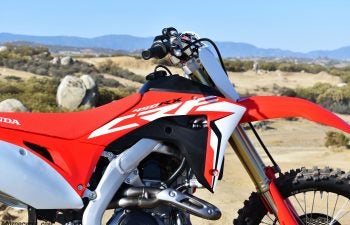
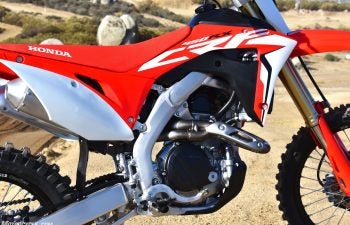
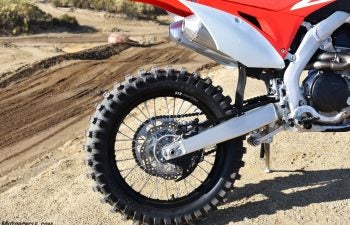
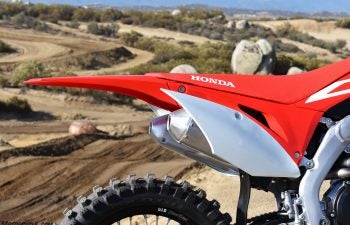
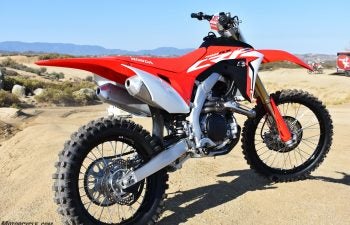
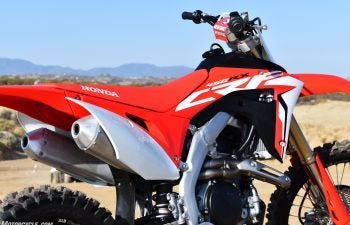
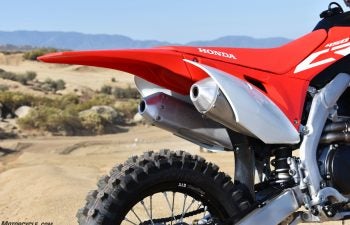



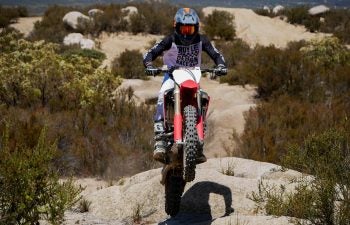
 Your Privacy Choices
Your Privacy Choices